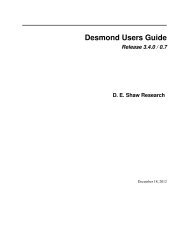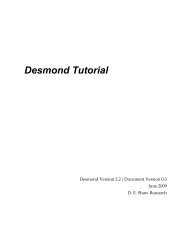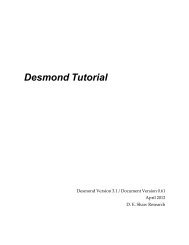Desmond Tutorial
Desmond Tutorial - DE Shaw Research
Desmond Tutorial - DE Shaw Research
- No tags were found...
You also want an ePaper? Increase the reach of your titles
YUMPU automatically turns print PDFs into web optimized ePapers that Google loves.
<strong>Desmond</strong> <strong>Tutorial</strong><br />
<strong>Tutorial</strong> Steps<br />
Figure 1.6 Changing from ribbon to ball-and-stick view<br />
Double-click the<br />
‘Draw Atoms in Ball<br />
and Stick’ icon.<br />
Click the ‘Color By<br />
Elements’ button.<br />
Once you have arrived at this point, you are ready to prepare the structure for simulation.<br />
Just having a molecular model in the workspace is not enough to perform molecular<br />
mechanics/dynamics calculations. You must prepare the protein model so that it<br />
corresponds as closely as possible to the biological system you are studying.<br />
From this view, it is clear that there are no hydrogen atoms in the protein structure.<br />
Moreover, there might be ill‐defined bond orders, protonation states, formal charges,<br />
tautomerization states, disulfide bonds, and so on. The red dots shown in the workspace<br />
represent crystal waters. All of these issues must be resolved before we can perform<br />
simulation calculations.<br />
There are two methods of correcting these issues: the Build Panel opens Maestroʹs<br />
general purpose molecular structure editor and the Protein Preparation Wizard is a<br />
very useful, automated tool for protein structure preparation. For this tutorial, we will<br />
use the Protein Preparation Wizard.<br />
9. Select Workflows > Protein Preparation Wizard from the menu bar.<br />
The Protein Preparation Wizard appears as shown in Figure 1.7.<br />
September 2008 D. E. Shaw Research 7






